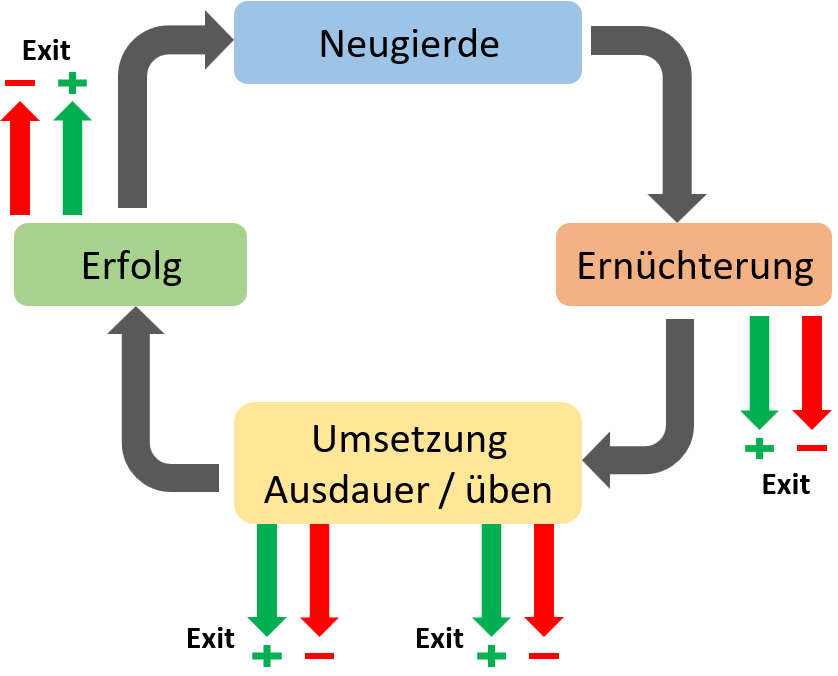Success Loop
From the idea to success. The Success Loop shows you the way!

The Success Loop (cycle of success) describes the path from an idea to the achievement of a set goal.
It can happen that you get to a point in the course of your success loop where you break off your project. Reasons for giving up can be both negative and positive aspects. Positive exit options are "healthy" reasons for leaving that do not create feelings of loss (e.g. to focus on something else that is more important at the moment). Negative exit options, on the other hand, result from personal patterns, negative emotions (e.g. defiance) or blockages.
In the following, the different phases of the success loop with its respective exit variants are explained using an example:

Curiosity
The process is initiated by curiosity about a topic or a specific objective.
Example: Thomas has always dreamed of getting a skydiving license as he has seen many videos about extreme sports and believes that this sport is right for him. Now he has set himself the goal of getting a skydiving license.
Sobering up
After you have dealt with the matter a little, the first real challenges become apparent. You develop an awareness that achieving the goal or implementing it will be more difficult or resource-intensive than originally thought.
Example: Thomas deals intensively with skydiving and the way to acquire the license. He reads a lot and informs himself extensively about the content and requirements for acquiring the license. He realizes that the exam and the (long-term) practice of skydiving requires more than just courage: Preparing for the exam requires time to learn the theory and money for the mandatory jumps. In addition, you need expensive equipment in the medium term, you have to be physically and mentally fit and it makes sense to be a member of an aviation club.
Negative exit option: Thomas is afraid of exams and convinces himself that he won't be able to pass the exam anyway.
Positive exit option: Thomas' girlfriend is expecting a child. Since acquiring the license and then regularly pursuing his hobby would take up a lot of time, which he would rather spend with his child, he gives up his goal.
Step into Action
After the sobering phase, the implementation phase begins. Steps are taken to achieve the set goal or to realize the idea. There are two exit points in the implementation phase. One is already shortly after the start of implementation, the other is before the end of implementation or in the middle of the implementation phase.
Starting the Training
Thomas booked his first weekend at the flight school. There he learns the theory and completes his first (tandem) jump.
Negative exit option: Thomas breaks off because he tells himself that he doesn't have what it takes to remember the theory topics.
Positive exit option: After his first jump, Thomas breaks off because he doesn't enjoy the sport as much as he had hoped.
Short before ending the Training
Thomas already had several courses in which he learned the theory and participated in some jumps. He has already invested a lot of time and money.
Negative exit option: Thomas breaks off because he tells himself that he has never finished anything and that it will therefore not work this time either.
Positive exit option: Thomas starts a professional retraining and therefore decides to devote his full attention to it.
Success
In this phase you “reap” what you sow. The goal was achieved or the idea was implemented. The exit here is only positive if the goal in life has been achieved and one rests on what has been achieved. As a rule – hence the loop – you then set yourself a new goal or have the next idea to be realized and start the process all over again.
Example: Done! Thomas successfully passed his exams and acquired his skydiving license. He is proud of himself for not giving up and sticking to his dream. He has taken a liking to high-altitude sport and is already looking for his next challenge: free climbing.
Negative exit option: Thomas has achieved his goal. However, due to negative thought patterns, he feels he doesn't deserve to do more.
Positive exit option: Thomas has achieved his goal. He didn't want more in life. He is perfectly happy and has no further goals and dreams.